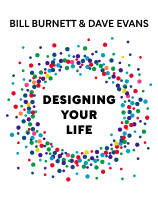

This article is an excerpt from the Shortform book guide to "Designing Your Life" by Bill Burnett and Dave Evans. Shortform has the world's best summaries and analyses of books you should be reading.
Like this article? Sign up for a free trial here .
How can the book Designing Your Life move you forward in life? What insights can you apply?
In the book Designing Your Life, Stanford professors Bill Burnett and Dave Evans share the content of their popular courses and workshops on life design. Using concrete principles and examples, they teach readers how to design a meaningful life in which they can truly thrive.
Keep reading to learn the basics of the book Designing Your Life.
Takeaways From the Book Designing Your Life
Everyone wants to make a living doing meaningful work that harmonizes with their values and makes them happy. But many people feel stuck in the wrong life doing unfulfilling work with no way out. Some hope that if only they can find their “true passion,” everything will magically fall into place. Both attitudes—the defeated one and the magical passion one—are false. What we need is a clear-cut process for designing our lives, a learnable approach to building a fulfilling career.
That’s what Stanford professors Bill Burnett and Dave Evans provide in the book Designing Your Life as they share the content of their popular courses and workshops on life design and teach solid principles and practices for living a meaningful life. Just as products from furniture to electronics are the result of careful design decisions, you can apply design thinking to your own life to create more coherence, meaning, and joy.
Design Thinking
Design thinking involves five mental attitudes: curiosity, experimentation, reframing, embracing process, and deep teamwork. The first two are self-explanatory. Reframing means getting a different perspective on your problems by rethinking false and dysfunctional beliefs and recognizing your own biases. Embracing process means you focus on the journey instead of the goal, enjoying the adventure instead of obsessing over its outcome. Deep teamwork means recognizing that design is a fundamentally collaborative, team-based process instead of a solitary artistic pursuit. You design your life in collaboration with other people.
Like many people, you may wrongly believe there’s a single “perfect” life for you. However, life design reframes the old question “What do you want to be when you grow up?” and asks instead, “What do you want to grow into?”
The design approach to life also rejects the popular notion that everything will work itself out if you just “find your passion.” Passion isn’t the cause but the result of intelligent life design.
Identifying Your Problem
The first step in tackling any design problem is to articulate the problem. This means taking stock of your situation and figuring out which things in your life aren’t working. It’s important to pick the right problem to work on, because choosing wrong could waste years of your life.
Your life design problem could relate to the type of work you do. Or it could relate to money, family, love, health, or a combination. Just make sure you don’t mistake facts for problems. For example, someone who wants to be a poet may agonize over the low pay and status of poets in contemporary society. This status is simply a fact. In design terms, it’s not a problem, because problems must be actionable. You can’t “solve” a fact. You can only accept it and start designing better responses to it.
Taking Stock of Your Life
To identify your life design problem, the book Designing Your Life urges you to take an inventory of four life areas: your health, work, joy, and relationships. Think of these four areas as making up a “dashboard” that tells you how your various “systems” are currently functioning. To use the dashboard, reflect on your present status in each of the four areas. Then consider how “full” each gauge is. How is your bodily health? How sharp and mentally engaged are you? How’s your emotional and spiritual health? How well is your work going, whether paid or unpaid? What do you do for pure fun and joy? How healthy and fulfilling are your relationships? Once you’ve filled out this dashboard, you’ll have an idea of how well your life is operating.
Creating Your Life Compass
To get where you want to go, it’s essential to know what you’re looking for. You may not always know exactly where you’re headed, but it’s possible to always know if you’re headed the right way. The practice of life design can help you identify this right way by teaching you to build a life compass.
Your life compass consists of two components. The first is your work philosophy, which includes everything you think and believe about work: what it’s for, why you do it, and what makes it good or bad. The second is your life philosophy. This includes everything you believe about the world and how it works: what it means, what gives it value, how your life relates to others, the place of money in a meaningful life, and the value you place on fulfillment and experience. To create your life compass, write a brief statement of your work philosophy and a separate statement of your life philosophy. Then compare them and see how they relate or conflict.
Creating your life compass provides a way to gauge your life’s coherence. For example, if you believe it’s important to leave a cleaner planet for the next generation, but you work for a large corporation that pollutes the skies and oceans, you’re experiencing incoherence.
Once you’ve written down your work and life philosophies and considered their coherence, you’ll know your life’s “true north.” At any given moment, you’ll be able to tell whether you’re heading in the right direction.
Wayfinding Your Life
Next, you can use your compass to practice the ancient art of wayfinding, which helps you know where you’re going without a firm destination in mind. Wayfinding gives you direction, while your compass helps you course correct. Wayfinding your life follows the principle that your sense of enjoyment will guide you to the right work.
To wayfind your life, pay attention to your sense of involvement, energy, and joy. For involvement, what activities and situations make you feel interested, focused, and excited? Conversely, what makes you feel bored and dull? For energy, notice how vital and alive you feel. Which activities energize you? Which ones drain you? For joy, pay attention to the activities that make you feel engaged and joyful, and also the ones that block these feelings.
The book Designing Your Life recommends that you keep a Wayfinding Journal consisting of two components. First is an activity log where you keep a list of your main daily activities and indicate how involved, energized, and joyful they made you feel. Second is a “reflections” section where you write down what you learn by examining your activity log and noticing any themes, insights, or surprises. Notice who you were with, what you were doing, where you were, and what you were interacting with (people, things, a machine?) as your involvement, energy, and joy rose and fell. You can also create a Wayfinding Journal from your past. Just apply the same journaling technique to memories of past work experiences.
Generating Ideas to Get Past Blocks
A major benefit of life design is that it helps you get “unstuck.” If you feel hopelessly stuck in the wrong job, for example, what you need is ideation: the skill of generating ideas. Approaching your blocks with a design mindset can generate more ideas than you ever thought possible.
Mind Mapping
The book Designing Your Life recommends mind mapping as a great way to generate new ideas. It works by free associating with words and ideas and generating a visual map of their relationships. A typical mind map is the “bubble map” of connected circles and words. To practice this for life design, pick a current problem or goal and write it in the center of a sheet of paper. Then built out layers of other concepts in connected circles around it using free association. Let the exercise uncover ideas you didn’t know were lurking in your subconscious. Then choose four or five interesting items from the outermost ring of words and “play around” with them to start generating solutions to your problem.
Use your Wayfinding Journal to find mind mapping topics. Pick something that you found intensely involving or energizing, and draw a mind map with it at the center. Then pick three items from the outer rings and use them to create potential descriptions for jobs that: A) you’d find enjoyable and meaningful, and B) other people would find helpful.
Designing Multiple Lives
The book Designing Your Life encourages you to create Odyssey Plans. To use the above techniques in tandem with the life design principle that there are multiple great lives you could lead—develop three separate five-year Odyssey Plans, each one detailing a different life that you could live. Focus your first plan on something you’ve already got in mind, either the life you’re actually living (imagined forward by five years) or a good idea that you’ve been developing. For your second plan, describe what you’d do if the area you currently work in or have been planning to work in disappeared. For your third plan, describe what you’d do if money and reputation didn’t matter.
For each plan, come up with a short title to capture its essence and a dashboard gauge that shows your available resources (time, money, skill, and so on), your “like level” (how much you like the plan), your confidence level in the plan, and how coherent the plan is with your life compass. Also note two or three questions that each plan raises.
The final step is to share your Odyssey Plans with a group of supportive people. You can’t always see yourself accurately. You need other people’s input. So pick some people you trust to provide honest and constructive reactions that will help guide your decisions.
Prototyping Your Future
The essence of design thinking in action is to build a potential solution to your problem so that you can test it. You can do this through prototyping your Odyssey Plans. Prototyping your life design enables you to ask the right questions, gain experience through experimenting with alternatives, and test your assumptions. It also enables you to “fail fast” (because you quickly learn what doesn’t work before you over-invest in a life path with no real future) and “fail forward” by using your failures to make progress. Moreover, it builds empathetic relationships with other people who are interested in your journey. The book Designing Your Life outlines two ways to use prototyping in life design: conducting life interviews and pursuing exploratory experiences.
Life Interviews and Exploratory Experiences
In a life interview, you learn from someone who actually knows what it’s like to live the life you’re contemplating, and you let this tell you whether that life is for you. Find someone who’s currently doing the work and/or living the life you’re considering. Ask them how they came to be doing this work and what it’s really like.
An exploratory experience would be an internship, a job-shadowing experience, or volunteer work. No matter what form it takes, think of it as a kind of “test drive” to give you real, hands-on experience and firsthand knowledge of the work and life you’re considering. Life interviews first can provide good ideas for exploratory experiences. If you feel stuck for ideas, use your Odyssey Plans to intelligently plot exploratory experiences. Pick a plan where the dashboard readings are high, and use the questions you wrote for that plan to guide you. You can also use mind mapping to generate ideas for life interviews and exploratory experiences.
The Problem With Job Searching
With your Odyssey Plans and prototype ideas, you may want to start searching for jobs right away, but first learn an important truth: Contrary to popular belief, the best route to fulfilling work isn’t through the want ads. For various reasons, the traditional job advertisement and job application processes are fundamentally broken. Most jobs are filled internally without ever being publicly shown. Fewer than half the applications submitted through the traditional route get a response. Many advertised jobs are really “phantom” jobs that were only published to meet a company requirement. Advertised job descriptions themselves are almost hopelessly defective, combining generic skills with impossible-to-meet requirements. This all means you need to revise your approach.
To improve your chances if you want to use the conventional job hunting approach of scouring the Internet and then sending in a cover letter and resume, write your resume to be amenable to keyword searches, using language from the actual job posting. Focus not on why you want the job but what you can do for the employer. If you get an interview, bring a fresh printed resume.
The Solution: Plugging Into the Hidden Job Market
The book Designing Your Life argues that a far better approach than simply applying to Internet-posted jobs is to combine effective networking practices with your prototyping technique of life interviews, which will enable you to tap into the hidden, unadvertised job market. Realize that you can design your own dream job through a combination of active seeking and co-creation. Also realize that networking is a good thing, not something that just annoys other people.
To network effectively, first reach out to your first-tier contacts, the people you actually know and have in your address files, and ask them for leads. Use this information to reach out to second-tier contacts (the contacts of your contacts). Also research people and organizations. Then request life interviews with interesting people in interesting positions. When you access a combined personal and professional network by conducting life interviews, you increase your likelihood of gaining access to the hidden job market. Often when one of your life interviewees sees your genuine interest, they’ll let you know of available positions, whether published or not.
Cap your exploration of the hidden job market by making a critical distinction in your job-searching activities: Since the defectiveness of job descriptions means you can’t really know what most jobs are about from reading about them, adopt the mindset that you’re not looking for a job but looking for job offers. This will expand your horizons and make you more curious, leading you to investigate and evaluate opportunities with genuine interest.
Choosing to Be Happy
According to the book Designing Your Life, the underlying goal of life design is happiness. This is what gives meaning to all the specific attitudes, steps, and techniques you’ve been learning. As a designer, realize that being happy comes from choosing well among the options you generate through life design, while being unhappy comes from choosing poorly. Both types of choice depend on your mental model. Realize that no “right choice” exists. There’s only good versus bad choosing. The latter involves a combination of choosing unwisely and then agonizing over it afterward.
To choose well, first collect and create options. That’s what you’ve already been learning to do here. Second, focus and narrow your list. Consider your list of life design options, then identify the top ones and cross off lesser options. Third, use careful discernment to choose, relying on non-cognitive ways of knowing to complement cognitive and intellectual knowing. To do this, pay attention to your intuitions, emotions, and body, and “listen” to what they “tell you.” Traditional ways of training yourself to engage with these other modes of knowing include journaling, yoga, tai chi, prayer, and meditation. Fourth and finally, make your choice boldly, and let go of any lingering doubts. Don’t rehash. Just concentrate on living well with the choice you’ve made.
Becoming Immune to Failure
A major benefit of life design is that it makes you immune to failure. This doesn’t mean you never experience failure again but that you don’t experience the negative feelings of self-recrimination that usually accompany it. You achieve this state by reframing your belief that failure is bad. As a life designer, you fail intentionally and fail more often because you practice the two life design attitudes of curiosity and experimentation. These lead you to generate ideas and build prototypes—which can fail. You also learn from failures that arise from your personal weaknesses and screw-ups. Productive failure contributes directly to who you become, both professionally and personally.
The book Designing Your Life explains that there’s a distinction between the productive failures of the design process and the psychological identity of “being a failure.” As a life designer, you’re always succeeding at the infinite game of finding who you are and meaningfully engaging with the world. This means you’re free to do and pursue whatever you want because you’re no longer afraid of how you’ll feel if things don’t work out the way you expected. When you encounter productive failures, you use them as learning experiences. You simply move on, armed with the new and useful data you gained from the failure. But you never think of yourself as a failure.
To help with the discipline of converting failures into growth opportunities, keep a “failure log.” Write down your failures and organize them into three categories: pure screw-ups, personal weaknesses, and growth opportunities. Focus on the latter, identifying what went wrong and how you could improve next time.
Creating Your Team
The final component of life design is to create a team to help you continue with your ongoing life design project. There are two levels to your team: a general team and a more specific one.
Your general team consists of people who play three different roles. Allies are friends and others who care about your life and willingly provide feedback on your plans. You can count on them to “be there” for you. Key players are direct co-workers in your life design efforts. Intimates are your family members and closest friends.
Your specific team consists of three to six people whom you pick from your general team to share your life design project directly. If possible, pick people whom you’ve already involved in your life design work by conducting life interviews or sharing your Odyssey Plans with them. Schedule regular meetings with this team, and establish rules for productive conversations. If possible, also include one or more mentors on your specific team. These are people who don’t so much tell you what to think as help you think for yourself and sharpen your own insights and decision-making. They listen closely to what you say and help you reframe defective beliefs. When you have to make decisions, they help with your discernment process.
Designing for the Rest of Your Life
From here on out, as you use your new skills to continually design the rest of your life, remember to apply the five design attitudes in all kinds of ways whenever you encounter situations that call for them. This will bring a continuous flow of information for you to incorporate into your design activities. Also remember to refer frequently to your life compass to assess how things are going: Are you remaining true to yourself? Is your life remaining coherent? Finally, commit fully to a practice for tuning into non-cognitive forms of knowing, such as journaling, meditation, or tai chi. This will help to keep you centered and in touch with your whole being. You’ll have a clearer mind and spirit as you design your life to maximize your fulfillment.
Finally, let go of the false belief that life design is a one-time activity, after which your life will be great. Life design never ends. It’s a joyful lifelong project.

———End of Preview———
Like what you just read? Read the rest of the world's best book summary and analysis of Bill Burnett and Dave Evans's "Designing Your Life" at Shortform .
Here's what you'll find in our full Designing Your Life summary :
- Why finding your "true passion" in life is a myth
- The five mental attitudes in design thinking
- How to design a meaningful life in which you can truly thrive






